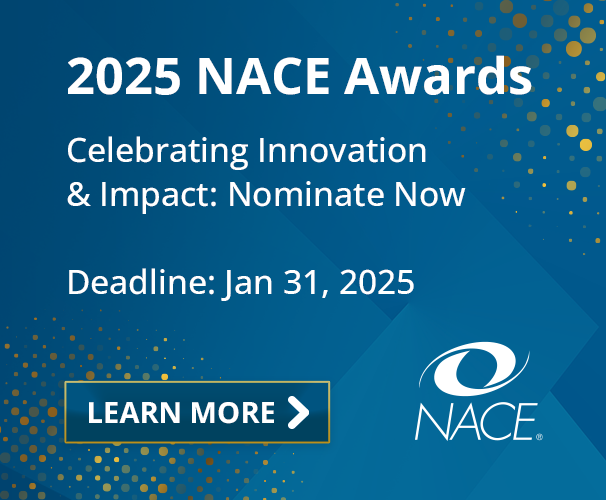Career services at Michigan State University (MSU) is a centralized/hybrid organization of offices and is well-known for its Career Services Network, which is composed of career services professionals strategically located in central and college-based offices.
Career services is a part of the newly unified division—Student Life and Engagement (SLE)—that is a merger of the areas of Student Affairs and Services and Residential and Hospitality Services.
“The new Division of Student Life and Engagement combines MSU’s student-facing services to help transform the student and guest experience,” says Jeff Beavers, executive director of career services at MSU, a large Research 1 university with 50,000 students, approximately 42,000 of whom are undergraduates.
“We have a new shared vision that includes care, safety, partnerships, staff development, and an increased commitment to DEIB. Most importantly, it is creating access to new resources for engaging and developing students; for supporting processes related to HR, finance, and technology; and for creating community and sense of belonging.”
He adds that it is also well timed, as fall 2022 is the start of a new two-year “live on campus” requirement that includes many new student development programs aimed at helping MSU achieve its highest goals for student success.
The Career Services Network is now part of the new Department of Student Development and External Relations (SDER).
“We are the only such department within SLE that has both an internal and external focus,” Beavers says.
“Others within our department are Fraternity and Sorority Life, Student and Community Relations, and the Office of Student Support and Accountability. It also includes the MSU College Advising Corps, which is positioned at school districts across the state to help students complete the college application and financial aid processes for pursuing postsecondary education.
“Overall, we have stronger relationships both internally and externally, enabling us to better connect employers to target student groups, whether registered student organizations or identity and affinity groups, and to other campus units and programs that also support student success.”
Additionally, SLE has expanded the career services team’s involvement in division- and campus-level committees and workgroups to 51 currently.
“This ensures we have representation in many important initiatives across campus and have the opportunity to commit resources where needed,” Beavers notes.
“It is expanding opportunity for alumni mentors and employer partners who can achieve their interest in campus engagement by working through their career services contact versus having to search contacts and opportunities on their own.”
One of the most notable areas of career services is the well-known and respected Collegiate Employment Research Institute (CERI), under the direction of Dr. Phil Gardner. This adds a vital research component to career services and has long served as a leading indicator of college graduate hiring trends. This has helped career services gain an additional level of credibility for the department within the campus, helping secure its strong position within the university structure.
The new SLE division has a full team committed to assessment. Previously, units within Student Affairs and Services managed this task separately.
“Now,” Beavers says, “we have shared subject matter experts and experienced assessment professionals to help us be more effective in both goal setting and data analysis. It is creating greater structure and consistency in how we set both short-term and long-term goals and ensure alignment to the 2030 Campus Strategic Plan.
“Although we have always maintained a core set of key performance indicators specific to job placement, student engagement, and employer engagement, our involvement within SLE and SDER has helped us expand our KPIs to also include new metrics for how we measure impact as a result of collaboration across the division.”
In the past three years, the career services office has aligned its career resources to “interest areas” used by the office of admissions to ensure it is creating a seamless transition for new students and supporting how they pursue both a major and a mission.
“We want them to think more broadly than a single major and expand their thinking on how they can leverage their MSU degree to pursue their career interest or apply their passion to a desired goal,” Beavers explains.
“Additionally, this fall we introduced new ‘interest area’ career advising that is creating alignment to a new academic advising model being implemented across campus. This collaborative approach to student success has enabled us to build even stronger partnerships with the office of admissions and the office of the associate provost for undergraduate education. The team-based approach to delivering this new service is also fostering additional cross training among the career professionals positioned with the colleges.”
He says that the inclusion of career services in SLE creates a stronger partnership with many other units that provide student support and development, including:
- Women’s student services;
- Veterans’ resource center;
- Volunteer programs;
- Multicultural center;
- Recreational sports and fitness;
- Graduate wellness;
- Student government;
- Campus gender and sexuality center;
- Fraternity and sorority life;
- Residential learning programs, and
- Student organizations.
“We support the recruiting process to fill nearly 17,000 campus jobs that provide opportunities for students to finance their education, gain and apply skills, and explore career pathways,” Beavers adds.
“SLE is the largest hiring unit.”
The budget model is comprised of two-thirds general and one-third discretionary. Staffing consists of 25 full-time employees and 40 student career peers. Career services is also central to the university's 2030 strategic plan with the areas of advising, alumni, and mentoring being highlighted, so even greater positioning of career services for the future is expected.
Beavers says the new alignment better addresses current needs and allows career services to be better positioned for the future.
“As we think about the future, we are already seeing a shift in how and where students learn,” he says.
“In the past, we planned and hosted most programs and events in person during late afternoons or early evenings. Now, online classes, hybrid courses, new residential learning communities, and our significant transfer student population are requiring us to think differently about advising access, workshop formats, operating hours and models, and integrated development programs.
“We also remain focused on student engagement from admissions acceptance until two years after graduation and how we increase student engagement beyond our current 70-plus percent level. As a campus, our goal is for every student to have at least two meaningful learning experiences, so the need for students to connect with career advisers and alumni mentors, participate in internships and undergraduate research, enroll in career-related courses, and seek other defining experiences has to begin within their first eight months as a Spartan.”




